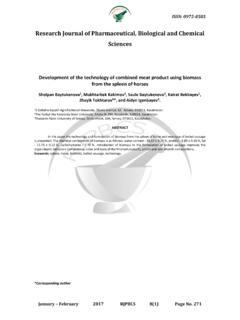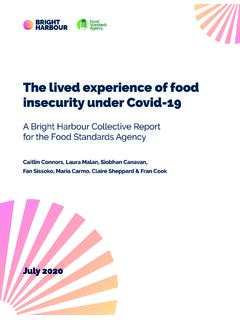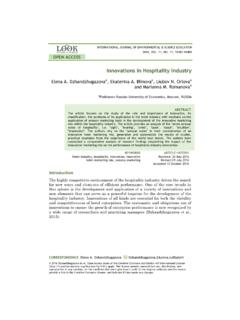Transcription of Selecting Foods of Children’s Cultural Backgrounds for a ...
1 Selecting Foods of Children s Cultural Backgrounds for a Preschool Menu: A Practical Solution Mary Smith, MS, RD; Jo Ann Nelson, PhD; Sara Starbuck, MS; and Hea-Ran L. Ashraf, PhD ABSTRACT Purpose/Objectives Rapidly growing racial and ethnic diversity in the United States has profound implications for foodservice and nutrition management in the nation s schools. Multicultural awareness among educators fosters appreciation and respect for the diverse eating habits among children and their families, thereby expanding learning experiences and nutrition services for children.
2 Government and professional organizations recommend that all grade levels, including preschool, include culturally relevant school food programs. The purpose of this study was to explore practical ways to select and incorporate Foods that reflect Cultural Backgrounds of children enrolled in a preschool located in a Midwestern university town. Methods A food committee composed of parents and staff members was established to oversee this project, and children participated in the process. Eighteen recipes, submitted by parents, were pre-screened by the food committee for suitability for service to children.
3 In an effort to improve nutritional composition, some modifications were made to several recipes to reduce fat, cholesterol, and sodium content. Nine recipes, including three main dishes, two side dishes, and four desserts, representing seven different ethnic Backgrounds , were recommended for inclusion in the menu through a taste-testing evaluation. Two recipes were adopted in the menu immediately, and the rest of the recipes were placed in the recipe file of the Child Development Laboratories (CDL) at Southern Illinois University at Carbondale. It was indicated that flavor influenced the acceptance of a dish more than appearance.
4 Applications to Child Nutrition Professional Through this project, children and staff were introduced to various unfamiliar ethnic dishes, and the pool of recipes for menu planning was expanded. At the same time, operational challenges in adopting new menu items, such as the limited skills of the kitchen staff and procuring unfamiliar ingredients, were identified. The strong commitment of management to diversifying the food program was found to be an important factor for the continued success of this approach. INTRODUCTION Diverse food cultures and habits of Americans make eating an interesting and enjoyable learning experience for children (Endres, 1994).
5 Early and frequent exposure to a variety of Foods is likely to encourage healthy eating habits throughout life. As Birch (1987) has demonstrated, the frequency of children s exposure to food is strongly related to their taste preferences. A recent study reported that in 1997, million of the million American children under 5 years of age were enrolled in some form of regular childcare arrangement during a typical week (Smith, 2002). It is estimated that there were more than 500,000 daycare provider sites in 2000. These sites include family childcare providers and preschool facilities sponsored by state and federal government agencies, churches, hospitals, employer programs, military bases, colleges and universities, and community service organizations (Marketdata Enterprises, 2001).
6 Traditionally, children were primarily influenced by their families. However, today s parents tend to be less reliable food providers than in the past (Achterberg, 1988; Satter, 1987) and childcare centers and preschool programs have assumed increasing responsibility for the provision of food . Caregivers and parents now share responsibility for forming positive feelings about food and promoting healthful eating practices in young children. The National Association for the Education of Young Children (NAEYC) recommends that childcare centers serve Foods that reflect children s Backgrounds (NAEYC, 1997).
7 As a goal for school and childcare foodservice professionals, the Department of Agriculture (USDA) Child Nutrition Programs encourages planning and preparing healthy meals that appeal to the ethnic and Cultural tastes of children ( food and Nutrition Services, 2003). In a recently announced joint position paper entitled, Nutrition services: An essential component of comprehensive school health programs, the American Dietetic Association (ADA), the Society for Nutrition Education (SNE), and the American School food Service Association (ASFSA) provide guidelines for culturally relevant programs: Students are more likely to select and eat school meals when Foods meet students taste and Cultural preferences and are served in a supportive, comfortable, attractive, and social environment.
8 School meals provide an opportunity to reflect and celebrate ethnic communities through preparation techniques and use of food products. Meals may be marketed in the classroom and related to the core curriculum; marketed in the cafeteria with signage and samples; and involve families through menus, take-home newsletters, invitations to family meals at school and at presentations at parent organizations (ADA, 2003). It is suggested that the use of ethnic food should be part of a child s environment as it extends children s understanding and appreciation of their own world and that of others (Wardle, 1991).
9 Multicultural educators warn, however, about the tendency for well- intentioned programs to adopt a tourist approach that emphasizes exotic differences between cultures (Derman-Sparks, 1989). A more meaningful approach is the sharing of Cultural experiences within the daily life of the classroom in ways that children can comprehend. The goal of this study is to explore a practical way of expanding an existing menu to reflect the Cultural diversity of the children enrolled in a preschool. Specific objectives were to 1) collect from parents recipes that represented the Cultural background of the children; 2) evaluate the nutrient contents of the recipes; 3) determine the acceptability of these recipes among children, parents, and staff; and 4) select and recommend approved recipes for inclusion in the menu.
10 METHODOLOGY The Child Development Laboratories (CDL) at Southern Illinois University at Carbondale serve children from the age of six weeks to six years and feature a developmentally appropriate and anti-bias curriculum with opportunities for experiential learning. The university environment and educational philosophy of CDL encourage children of families with diverse Backgrounds to attend. The center is licensed by the State of Illinois for a total of 69 children. At the time of the study, 33% of these children were from immigrant or international families. Twenty-eight children, age three to six may be in attendance in the preschool at one time.
















